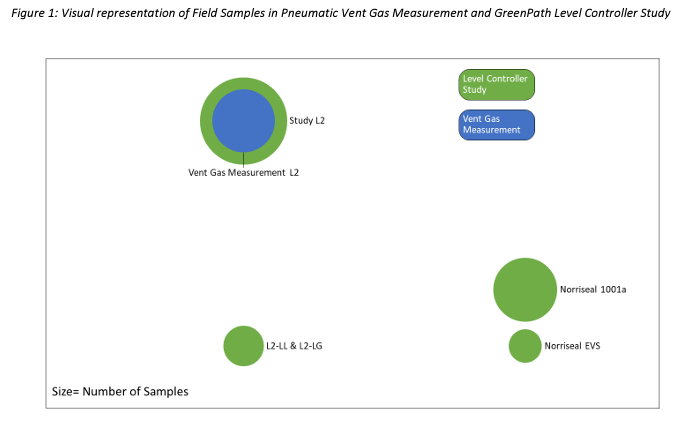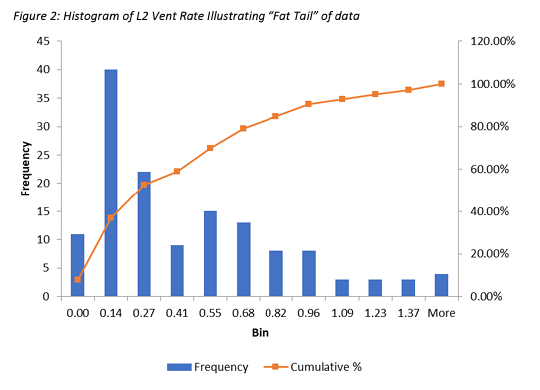Greenpath Energy Ltd.
October 19, 2018
Executive Summary
GreenPath Energy has undertaken a detailed analysis of level controller emissions for the two most common modern level controllers (Fisher L2 and Norriseal 1001a) in western Canada and their low emission equivalents (Fisher L2sj, L2-LL, L2-LG, Norriseal EVS). Over 200 measurements were made across a diverse group of operators (accounting for approximately 30% of operating gas wells in Alberta) to establish a reasonable baseline for emissions reporting and vent reduction potential of low-emissions level controllers.
Good data exists for the conversion of pressure controllers and transducers to lower emission equivalents, but a similar dataset does not exist for level controllers. Emissions from active level controllers are largely attributed to dynamic and transient emissions which are not accounted for in manufacturer-provided steady state emissions. This study shows that conservative emissions reduction of 50tCO2e/year is available from the conversion of high emission level controllers to low emission equivalents. Assuming 40,000 eligible level controllers exist in Alberta, this equates to a 2 million tonne annual reduction that was not previously considered by stakeholders.
Installing improved L2 relays (referred to as L2-LL and L2-LG for the Liquid-Liquid and Liquid-Gas interface they are designed for) showed reductions consistently above 80% on level controllers with baseline emissions greater than 0.5 m3/hr of fuel gas equivalent (FGE).
The initial sample of Norriseal retrofits did not draw upon the same high-emitting population, and results from the initial sample set were mixed. A subsequent project which focused on high-emitting Norriseal controllers showed an emission reduction greater than 90%. The quality of data for the Norriseal controllers is not as robust as the reductions achieved from the improved Fisher L2 relays.
The retrofits executed in support of this project could generate offsets under the Quantification Protocol for Greenhouse Gas Emission Reductions from Pneumatic Devices (version 2.0) in Alberta. Based on $30/tonne and assumptions detailed in the study, the deployment of 30 L2 controller relays and 30 EVS retrofits could result revenue of greater than $380,000 to participant companies if offsets are pursued and as well as fuel gas savings of approximately $36,000 to January 1, 2023.
The baseline samples were randomly selected to minimize bias. In each cohort of sites by company, all sites were assigned a random number in Microsoft Excel, then ranked. The top 15 ranked sites (which should account for 30 level controllers) were selected for sampling. If the operator had reason to exclude the site (site inaccessible; site shut in), the next-ranked sites were added to the survey list. These baselines presented diverse operators but were largely focused from Grande Prairie to Red Deer areas, where previous studies showed that level controllers were common (GreenPath Energy on Behalf of Alberta Energy Regulator, 2017).
The surveys were carried out using the Spartan Enhanced Measurement Emission Accuracy Solution (e-MEAS™) and a positive displacement meter outfitted with the Calscan Hawk 9000 data logger (Calscan Meter) to compensate for ambient temperature and pressure, where required. Use of e-MEAS™ or Calscan was driven by operator preference as the use of e-MEAS™ was more invasive, requiring the fuel gas supply system to be spliced into. For a perspective on the differences between the e-MEAS™ measurement tool and the Calscan system, please refer to the PTAC study on Pneumatic Vent Gas Measurement2. The Pneumatic Vent Gas Measurement study demonstrated a slight differential between measurements via e-MEAS™ measurements and Calscan measurements, but a correction factor between the two methods has not been achieved. Generally, at high vent rates the Calscan meter underrepresents rates. Either measurement tool is sufficient for the quantification of high-emitting level controllers and the retrofit.
There is significant overlap between the 17-ARPC-06 (Pneumatic Vent Gas Measurement) set and the dataset presented in this study shown in Figure 1 below. This level controller study includes 139 baseline samples taken in the first round of study, as well as 30 pre and post samples for the Fisher L2 relays, and 25 pre and post measurements of Norriseal 1001a. In total over 300 level controllers were measured for the study. An anonymous version of the data has been included in Appendix A: Anonymous Measurement Data.

In addition, a client of GreenPath allowed for data collected after the study period to be added to the report. This data significantly enhances perspectives on emissions reductions from both Norriseal 1001a to EVS conversions as well as conversions to the Fisher L2sj. This data is not random, however, and of lesser value than the randomized samples.
The distribution of results shows emissions from level controller are dominated by a “fat tail” and that a small number of high emitting level controllers are responsible for a disproportionate share of emissions. The low emission alternatives deployed on operating wells showed significant emission reductions in the case of the Fisher L2-LL and L2-LG relays. Improving the pneumatic efficiency of these high-emitting devices represents the most cost-effective means available to industry to achieve methane reduction.

A challenge in developing this project was the lack of pneumatic inventories in Alberta. Locating the low emission Fisher L2sj as well as the Norriseal EVS proved particularly fruitless despite working with vendors and producers for over six months to locate the low emission devices. In addition, locating Norriseal 1001a controllers proved to be difficult, as a field which an operator had designed to be “mostly Norriseal 1001a” based on inventory was determined (after random site selection) to yield 24 Fisher L2 and 6 Norriseal 1001a level controllers. In total, via random sample, GreenPath was only able to secure 14 Norriseal units despite three different measurement campaigns to secure the required number of samples.
Initial field surveys hoped to capture a Fisher L2sj inventoried as an L2, or a Norriseal 1001 EVS inventoried as a 1001a, but these efforts proved unsuccessful, a different pathway was selected. After over 100 Fisher L2 and Norriseal 1001a were inventoried and measured, no low-emission level controllers were found. The only remaining pathway was through bench tests with set process conditions and changes from an L2 to L2sj and Norriseal 1001a to EVS, respectively. Bench tests would be of lesser value than field studies in real world process conditions.
Instead, to pilot the Fisher L2 improved relay (pilot models were released only a few weeks prior to field trials) as well the Norriseal EVS retrofit kit, GreenPath worked with producers from the first round of measurements, and other producers who had not been engaged in the first round of surveys. All improved Fisher L2 relays were gifted to the project by Spartan. Three EVS retrofit kits were gifted to the project by Alberta Oil Tool, with the remaining 27 purchased by GreenPath for the project.
L2 RETROFITS
Sites with higher than average emission rates were selected from the initial sample pools to be targeted for retrofit and replacement, as low-emitting level controllers do not represent an opportunity for industry to reduce emissions. Additionally, bench tests showed the improved Fisher L2 relay carried significant potential to reduce emissions from level controllers in active control loops.
For retrofit sites, measurements were taken pre and post to ensure that changes in process condition (well decline, plunger position) did not affect the overall result. This step increased time on site (incurring costs) but ensured that the results were more representative of reductions achieved.
The retrofits occurred the same day in the same process condition to isolate the effect of the different relays and retrofit on the results. An average reduction in emissions of 84% was observed in the improved L2 relays within the sample. Relay change outs were executed in under 10 minutes, with no disruption to process.

The emission rates presented from the improved relay are conservative as the average emission rates of the preretrofit population are higher than the original sample, thus in the general population an emission rate less than 0.10m3/hr would be expected.
Assuming offsets are valued at $30/tonne from 2018 to 2022 and that the fuel gas is 90% methane operating at 7880 hours per year, these conversions could generate $280,000 in revenue for the participant company if offsets are pursued. In addition, assuming $1.6/MMBtu for 2018, $0.6/MMbtu for processing and assuming a flat price forecast, the saved gas is worth a further $23,000 to December 31, 2022.
NORRISEAL RETROFITS
One of the basic problems from this study was the lack of Norriseal controllers inventoried. One operator volunteered a field with Norriseal controllers, but ownership of the assets changed hands and the operator was then unable to participate in the study. Similarly, an early participant also had a change of ownership and was unable to participate in the retrofit pilot. Of the original participants involved in the project, one did not wish to retrofit the Norriseal based on operator preference. The other faced logistical challenges and only had a small number of Norriseals with baseline measurements.
To address this gap, GreenPath reached out to operators to determine if they had a population of Norriseals and were willing to participate in the study. GreenPath was able to find a further three operators with a reliable inventory of Norriseals; however, there were no “pre” measurements and data was unavailable to screen for high emitting sites. As such, random sites were selected and retrofit on site. Consequently, there was inconsistent quantities of high emitters to draw from to develop a reduction estimate similar to that presented for L2 Relay changes. Of the 20 additional Norriseal level controllers randomly selected, only one site had a premeasurement greater than 0.17 m3/hr3 and the total population had average emissions of 0.05m3/hr.
In the post measurement, two of the samples had to be excluded as there was a dump event in the project but not in the baseline. When these two instances are excluded, the level controllers with EVS retrofits installed had an average emission rate of 0.025m3/hr.
GreenPath has recently been working with a producer on measurement of level controllers; the producer has agreed to provide their data to the study on condition of anonymity. In this case, all level controllers were measured in a few pilot fields and only the highest emitting level controllers were selected for retrofit. This sample did not follow the procedure of the previous random samples. Instead:
The results of these additional seven measurements on high-emitting Norriseal controllers were promising. The seven high-emitting Norriseals had average emissions of 0.90m3/hr in baseline measurements. After retrofit, the average emissions were 0.046m3/hr. Further testing of high-emission Norriseal controllers should be undertaken to determine if this pattern holds true for all high emitting devices.
From this sample of seven retrofitted level controllers, offset revenue of $104,000 could be realized as well as $8,500 in gas savings to December 31, 2022, using the same assumptions regarding methane content and operating hours.
# 16-ARPC-03